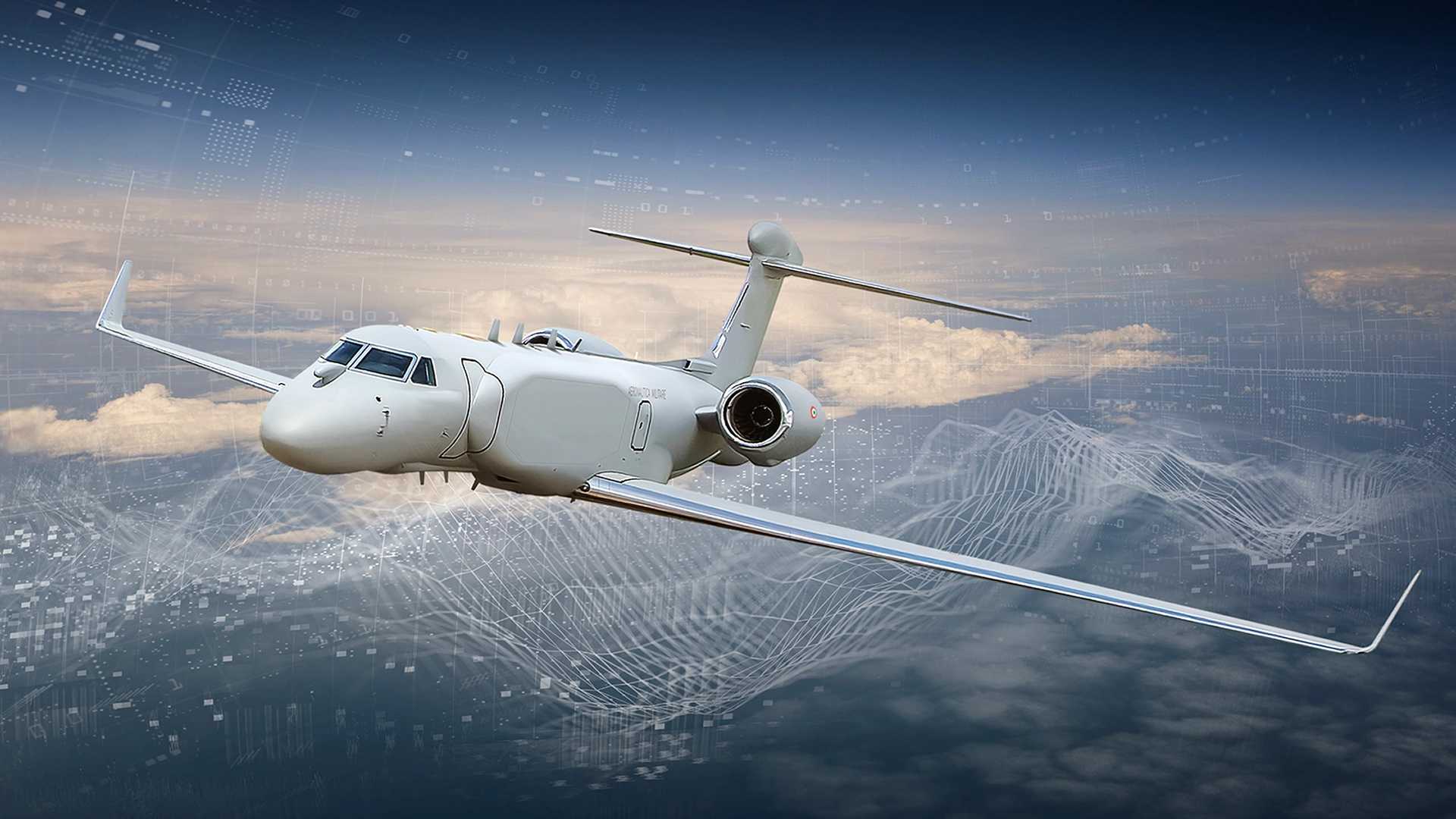Italy converts first US business jets into EA-37B Compass Call for long-range electronic warfare

{loadposition bannertop}
{loadposition sidebarpub}
On July 21, 2025, Italy signed a $300 million contract with L3Harris Technologies to convert two Gulfstream G550 business jets into EA-37B Compass Call airborne electronic attack platforms. This marks the first export of the EA-37B and follows a U.S. State Department approval of a Foreign Military Sale (FMS) for a total estimated value of $680 million.Follow Army Recognition on Google News at this link
The first tranche of the Italian program, valued at €1.2 billion, funded two fully mission-capable aircraft and six “green” G550 airframes for future conversions to electronic warfare variants. (Picture source: BAE Systems)
The two aircraft are part of Italy’s broader modernization program under the Piattaforma Multi-Missione, Multi-Sensore (P-MMMS) and the Joint Airborne Multi-sensor Multi-mission System (JAMMS) initiative. The agreement includes mission systems, integration support, crew training, ground systems, logistics, and publications. Italy’s two EA-37Bs will join its existing G550-based special mission fleet, which includes Conformal Airborne Early Warning (CAEW) and intelligence aircraft.
Also on July 21, 2025, BAE Systems received a $12 million subcontract from L3Harris to provide racks, radomes, cables, and harnesses necessary for mission system integration. The airframes will be modified at Gulfstream’s Savannah, Georgia facility, then sent to L3Harris’s Waco, Texas site for equipment installation. The EA-37B is derived from the Gulfstream G550 and powered by two Rolls-Royce BR700-710 C4-11 turbofan engines, each generating 15,385 pounds of thrust. The aircraft measures 29.4 meters in length, has a wingspan of 28.5 meters, a maximum takeoff weight of 44,452 kilograms, a range of 8,167 kilometers, a service ceiling of 13,716 meters, and a cruising speed of 767 mph. Its reduced crew size of nine personnel, enabled by automation and optimized interface design, lowers operational workload and supports mission performance.
The EA-37B will be equipped with the Compass Call electronic attack system, which includes Network Centric Collaborative Targeting (NCCT), System Control and Monitoring, Radio Frequency Receivers (RFR), Software-defined Radios (SDR), Counter Radar Assemblies, and conformal array panels. It will also feature AN/ARC-210 RT-2036 radios, KG-250 inline encryptors, KY-100 wide and narrowband terminals, KIV-77 IFF Mode 4/5 systems, and AN/PYQ-10C Simple Key Loaders. The aircraft’s architecture, known as System-Wide Open Reconfigurable Dynamic Architecture (SWORD-A), allows rapid integration of new systems. While the Italian Air Force has not disclosed whether it will receive Baseline 3 or Baseline 4, the latter includes BAE Systems’ SABER (Small Adaptive Bank of Electronic Resources), supporting software-based upgrades and modular capability enhancements.
The two aircraft are expected to be delivered starting in 2027, with one arriving a year after the U.S. Air Force EA-37B becomes operational. The JAMMS program, under which the aircraft are being acquired, has a total budget of €3.02 billion and includes a plan for ten G550-based aircraft. The first JAMMS tranche allocated €1.2 billion for two fully mission-capable aircraft and six green airframes. The second, worth €925 million, funds the conversion of four of those aircraft. Italy previously acquired two G550 CAEW aircraft equipped with EL/W‐2085 radars and is also receiving two G550-based JAMMS configured for SIGINT. The National Armaments Directorate approved the conversion of two green G550s to electronic attack configuration in 2023 and identified the EA-37B as the only system meeting Italy’s requirements.
The Compass Call program originally started as a rehost initiative to replace the EC-130H with a more modern platform. The EA-37B integrates legacy mission functions into a smaller, faster G550 airframe, with improvements in survivability, range, and system flexibility. The EC-130H flew for the first time in 1981, was retired after decades of use, and participated in operations in Iraq, Afghanistan, and Yugoslavia. By 2025, five EA-37Bs had been delivered to the U.S. Air Force out of a planned fleet of ten. The EA-37B complements other U.S. electronic warfare systems including the EA-18G Growler and F-16CM SEAD platforms. Italy’s aircraft will be structurally similar to its CAEW variants, including fuselage fairings and a bulbous tail. The G550 platform was chosen for its size, range, and ability to operate from shorter runways, and its origin in the civilian sector facilitates cost-effective upgrades and availability of spare parts.
The platform will allow Italy to conduct Suppression of Enemy Air Defenses (SEAD), counter-C5ISRT missions, and operations in anti-access/area-denial (A2/AD) environments. The EA-37B will support real-time signal detection, jamming, data fusion, and communication disruption without relying on kinetic engagement. It is designed to integrate with Italy’s existing fleets, including the F-35 and Eurofighter Typhoon, and is aligned with NATO’s requirements for joint all-domain operations. While the aircraft offers capabilities comparable to Germany’s Tornado ECR in the electronic domain, it exceeds legacy systems in endurance and upgrade flexibility. No offset agreements have been announced, but future domestic collaboration is possible, especially in software, maintenance, and training, under Italy’s €7.8 billion aerospace innovation strategy.
The aircraft’s modular system design and SABER’s open architecture allow Italy to adopt third-party software and add capabilities over time. The program has already demonstrated the integration of external applications on U.S. platforms using non-proprietary development kits. The EA-37B’s ability to rapidly adapt to new threats is being developed in parallel with efforts in cognitive electronic warfare, including tests with the Angry Kitten ECM pod. The platform’s potential to support future electromagnetic warfare concepts makes it relevant beyond its initial configuration. With Indo-Pacific allies showing interest in the platform and growing demand within the U.S. Air Force, Italy’s acquisition is viewed as a key step in expanding the aircraft’s role in allied operations. This investment reinforces Italy’s position in NATO’s southern flank and provides long-range electromagnetic support for multinational missions.

{loadposition bannertop}
{loadposition sidebarpub}
On July 21, 2025, Italy signed a $300 million contract with L3Harris Technologies to convert two Gulfstream G550 business jets into EA-37B Compass Call airborne electronic attack platforms. This marks the first export of the EA-37B and follows a U.S. State Department approval of a Foreign Military Sale (FMS) for a total estimated value of $680 million.
Follow Army Recognition on Google News at this link
The first tranche of the Italian program, valued at €1.2 billion, funded two fully mission-capable aircraft and six “green” G550 airframes for future conversions to electronic warfare variants. (Picture source: BAE Systems)
The two aircraft are part of Italy’s broader modernization program under the Piattaforma Multi-Missione, Multi-Sensore (P-MMMS) and the Joint Airborne Multi-sensor Multi-mission System (JAMMS) initiative. The agreement includes mission systems, integration support, crew training, ground systems, logistics, and publications. Italy’s two EA-37Bs will join its existing G550-based special mission fleet, which includes Conformal Airborne Early Warning (CAEW) and intelligence aircraft.
Also on July 21, 2025, BAE Systems received a $12 million subcontract from L3Harris to provide racks, radomes, cables, and harnesses necessary for mission system integration. The airframes will be modified at Gulfstream’s Savannah, Georgia facility, then sent to L3Harris’s Waco, Texas site for equipment installation. The EA-37B is derived from the Gulfstream G550 and powered by two Rolls-Royce BR700-710 C4-11 turbofan engines, each generating 15,385 pounds of thrust. The aircraft measures 29.4 meters in length, has a wingspan of 28.5 meters, a maximum takeoff weight of 44,452 kilograms, a range of 8,167 kilometers, a service ceiling of 13,716 meters, and a cruising speed of 767 mph. Its reduced crew size of nine personnel, enabled by automation and optimized interface design, lowers operational workload and supports mission performance.
The EA-37B will be equipped with the Compass Call electronic attack system, which includes Network Centric Collaborative Targeting (NCCT), System Control and Monitoring, Radio Frequency Receivers (RFR), Software-defined Radios (SDR), Counter Radar Assemblies, and conformal array panels. It will also feature AN/ARC-210 RT-2036 radios, KG-250 inline encryptors, KY-100 wide and narrowband terminals, KIV-77 IFF Mode 4/5 systems, and AN/PYQ-10C Simple Key Loaders. The aircraft’s architecture, known as System-Wide Open Reconfigurable Dynamic Architecture (SWORD-A), allows rapid integration of new systems. While the Italian Air Force has not disclosed whether it will receive Baseline 3 or Baseline 4, the latter includes BAE Systems’ SABER (Small Adaptive Bank of Electronic Resources), supporting software-based upgrades and modular capability enhancements.
The two aircraft are expected to be delivered starting in 2027, with one arriving a year after the U.S. Air Force EA-37B becomes operational. The JAMMS program, under which the aircraft are being acquired, has a total budget of €3.02 billion and includes a plan for ten G550-based aircraft. The first JAMMS tranche allocated €1.2 billion for two fully mission-capable aircraft and six green airframes. The second, worth €925 million, funds the conversion of four of those aircraft. Italy previously acquired two G550 CAEW aircraft equipped with EL/W‐2085 radars and is also receiving two G550-based JAMMS configured for SIGINT. The National Armaments Directorate approved the conversion of two green G550s to electronic attack configuration in 2023 and identified the EA-37B as the only system meeting Italy’s requirements.
The Compass Call program originally started as a rehost initiative to replace the EC-130H with a more modern platform. The EA-37B integrates legacy mission functions into a smaller, faster G550 airframe, with improvements in survivability, range, and system flexibility. The EC-130H flew for the first time in 1981, was retired after decades of use, and participated in operations in Iraq, Afghanistan, and Yugoslavia. By 2025, five EA-37Bs had been delivered to the U.S. Air Force out of a planned fleet of ten. The EA-37B complements other U.S. electronic warfare systems including the EA-18G Growler and F-16CM SEAD platforms. Italy’s aircraft will be structurally similar to its CAEW variants, including fuselage fairings and a bulbous tail. The G550 platform was chosen for its size, range, and ability to operate from shorter runways, and its origin in the civilian sector facilitates cost-effective upgrades and availability of spare parts.
The platform will allow Italy to conduct Suppression of Enemy Air Defenses (SEAD), counter-C5ISRT missions, and operations in anti-access/area-denial (A2/AD) environments. The EA-37B will support real-time signal detection, jamming, data fusion, and communication disruption without relying on kinetic engagement. It is designed to integrate with Italy’s existing fleets, including the F-35 and Eurofighter Typhoon, and is aligned with NATO’s requirements for joint all-domain operations. While the aircraft offers capabilities comparable to Germany’s Tornado ECR in the electronic domain, it exceeds legacy systems in endurance and upgrade flexibility. No offset agreements have been announced, but future domestic collaboration is possible, especially in software, maintenance, and training, under Italy’s €7.8 billion aerospace innovation strategy.
The aircraft’s modular system design and SABER’s open architecture allow Italy to adopt third-party software and add capabilities over time. The program has already demonstrated the integration of external applications on U.S. platforms using non-proprietary development kits. The EA-37B’s ability to rapidly adapt to new threats is being developed in parallel with efforts in cognitive electronic warfare, including tests with the Angry Kitten ECM pod. The platform’s potential to support future electromagnetic warfare concepts makes it relevant beyond its initial configuration. With Indo-Pacific allies showing interest in the platform and growing demand within the U.S. Air Force, Italy’s acquisition is viewed as a key step in expanding the aircraft’s role in allied operations. This investment reinforces Italy’s position in NATO’s southern flank and provides long-range electromagnetic support for multinational missions.





